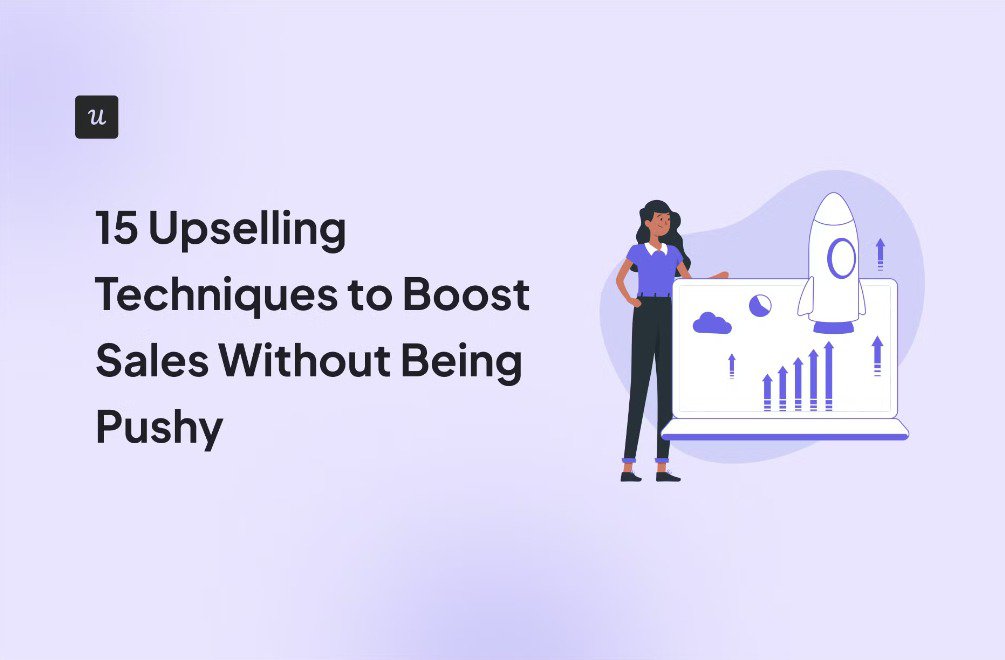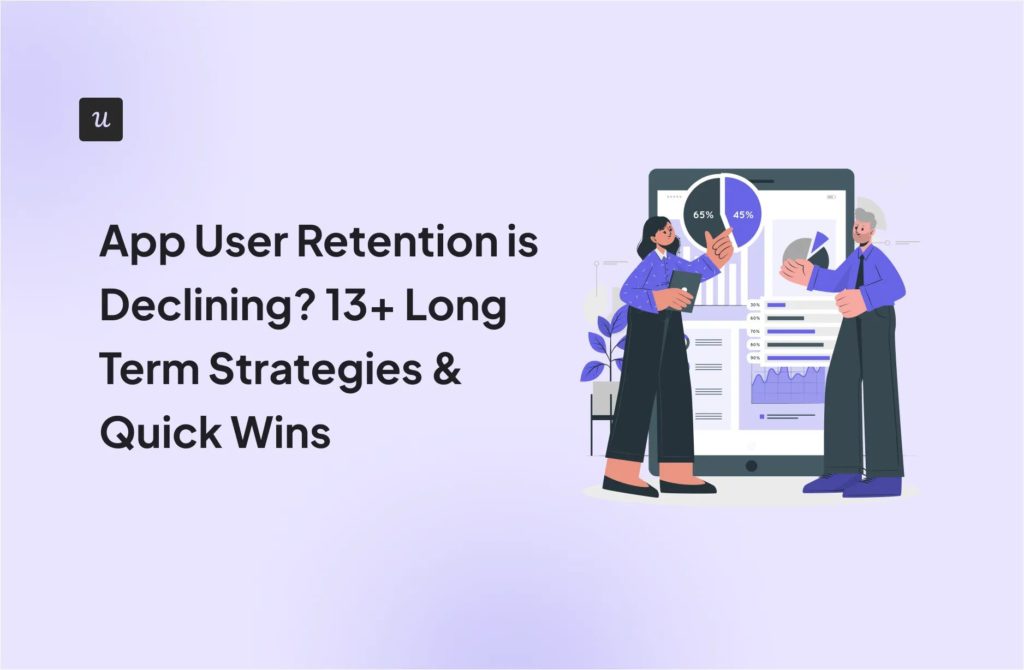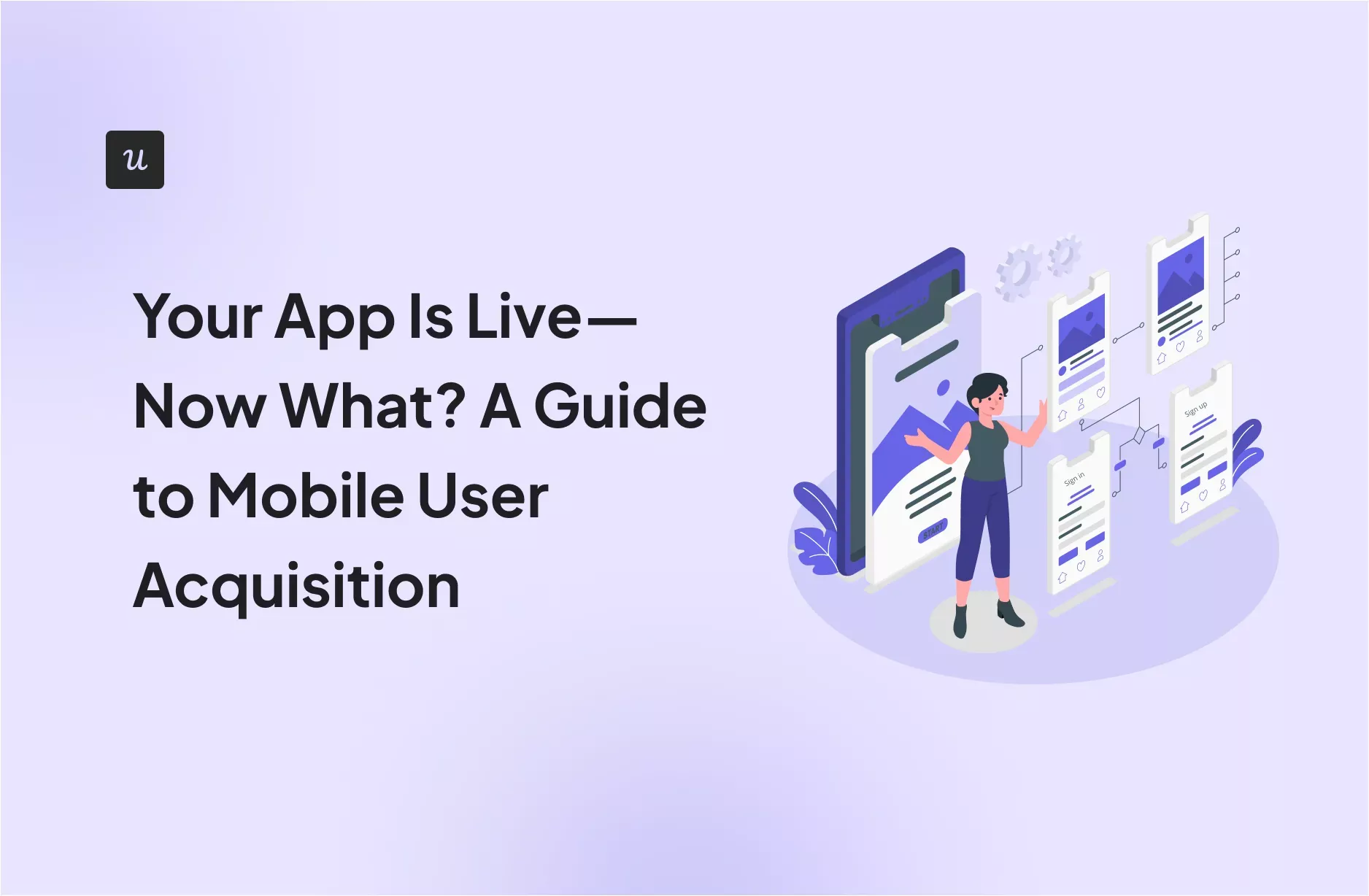
Scared of driving customers away with your pushy upselling techniques? Guess what—upselling doesn’t have to be intrusive or annoying. There are far more subtle ways to address customer problems through upselling without frustrating them.
If you’re pressed for time, here’s the short takeaway—offer contextual prompts, limited-time trials or discounts, personalized recommendations, and social proof.
If you’re here for deeper insights into effective product management tactics—let’s dive in! These 15 proven upselling strategies, tailored for SaaS, e-commerce, and mobile apps, will help you successfully increase sales and master the art of subtlety.
Get The Insights!
The fastest way to learn about Product Growth, Management & Trends.
Upselling techniques to use in SaaS and enhance customer satisfaction
You’ll find many upselling strategies focused solely on increasing profit margins, often at the expense of customer satisfaction. Needless to say, those don’t work. Instead, try these effective upselling examples specifically designed for SaaS.
Use FOMO to drive users from freemium to the premium version
FOMO (Fear of Missing Out) is an age-long marketing tactic that provides great results, provided the target customer is interested in what you’re selling. The premise is simple—customers only agree to an upsell if they see how it benefits them and don’t want to miss out.
Use this to your advantage by giving customers a glimpse of the exclusive features they’re missing if they fail to upgrade from freemium to premium. For instance, track customer behavior to identify user problems, then use targeted messages to showcase how relevant premium features solve these issues.
The productivity tool Miro is a good example. It allows freemium users to create three boards and then periodically sends reminders that the boards are public to all team members, whereas premium users can create private boards.

Implement tooltips to contextually prompt upgrades
Instead of randomly sending upgrade offers, use contextual prompts to successfully persuade customers. These timely messages maximize impact since customers actually require a solution in those moments.
For example, don’t wait for new customers to exhaust their current plan’s resources before upselling them. Just try contextual prompts to drive home the need for an upgrade.
Implement this upselling strategy using contextual tooltips that carry upgrade messages related to the feature’s limitations. Harvest does this well with its in-app tooltip example. It displays all features for creating projects but adds an upgrade tooltip next to premium add-ons, like data import.

Offer your power users to try the premium version of your product for a limited time
A great way of improving your freemium conversion rate is by offering a limited-time trial. This increases the likelihood of customers upgrading once they experience the value of premium features first-hand.
For even greater impact, you can segment your customers to identify power users. Since power users are heavily invested in your product, they’re more likely to benefit from premium features. Plus, only offering trials to a specific segment makes them feel special and helps boost customer loyalty as well.
Asana is known for applying this strategy of showcasing its premium features to highly engaged users with an in-app modal.

Trigger upgrade prompts when existing customers reach the account limits
There’s no better opportunity to suggest an upgrade than when a user reaches the limits of their current plan. Loom, the video communication platform, has mastered this craft of upsell marketing.
Loom allows new customers to record videos on the free plan but limits each video to a maximum of 5 minutes. Whenever a user reaches the 5-minute limit, an account expansion prompt is triggered, telling them to get more time by upgrading to premium.
Because these upselling in-app communication modals appear at just the right time, customers are more likely to act.

Segment free trial users and prompt them to upgrade before the trial ends
Limited-time free trials allow users to experience the value of your product without paying for the premium version. And while that benefits the user, don’t lose sight of what your goal is—getting more upgrades.
So, before the free trial runs out, segment relevant customers and send a reminder prompting them to upgrade. This works because it creates a sense of urgency and reiterates the product value users just unlocked.
That’s what Figma does with its blended upgrade in-app messages. Figma uses a countdown timer positioned at the top of its UI to remind trial users that time is running out. It combines this long message with a shorter one (by the side) to ensure it isn’t missed.

Upselling techniques to use in e-commerce
If you run an e-commerce website, you’re probably thinking that the customer expansion strategies above aren’t for you. Don’t worry! Now, we’ll consider the most effective upselling techniques for e-commerce platforms.
Make it easy for customers to add upsold products to their cart
Regardless of your chosen sales technique, simple always trumps complex. For e-commerce platforms, this means removing friction and making it easy for customers to add upsold products to their cart.
Apple serves as a worthy example with its MacBook product landing pages. Customers can easily view details and switch to higher-end device configurations with just one click.
Another key element to note is that Apple provides limited upsell opportunities to pick from. Offering too many options leads to psychological customer friction. Customers get confused, struggle to choose, and go ahead with their original purchase, declining additional offers.

Offer customers bundled products to increase the average order value
Bundling, a blend between upselling and cross-selling strategies, is a common sales technique used in e-commerce. It involves putting multiple products in a single package to increase sales by encouraging customers to buy more together.
To be effective, your bundle must combine two or more related (even essential) products. It also helps if you offer a discount along with the bundle to increase its perceived value.
Amazon is a leader in successfully bundling and cross-selling products. For example, the bundle below combines a steamer with protective gloves. The customer gets a deal, and Amazon makes a bigger sale.

But there are more benefits at play here for Amazon. Bundling increases the average transaction value, which ultimately boosts growth metrics such as customer lifetime value.
Identify customer needs to recommend relevant products
One easy way to upsell in e-commerce is by using customer data to offer recommendations. Start by adding a product recommendation widget at the end of a page. This simple addition works great by getting shoppers to purchase more products and making cross-selling easier.
Of course, the recommendations should be relevant to the customer’s needs. This brings us back to analyzing customer data, like their search history or tracking clicks. You can also recommend products related to what’s on the page or show what other customers with similar needs have bought.
Once again, Amazon is a master of product recommendation, showing what others bought when they had similar wants and needs. The recommendations are non-intrusive, appearing more like compelling suggestions than pushy sales tactics.

Present reasonable alternatives
Typically used for retail upselling, this product funnel strategy involves offering relevant but higher-priced items as alternatives to the customer’s original choice.
As with every good recommendation, the alternatives must be related to the initial product customers were considering. Presenting these suggestions makes it easy for them to add something else to their cart before checking out.
You’ll see a similar sales technique used for cross-selling as well. However, the two are not the same since cross-selling involves suggesting complementary items rather than higher-priced alternatives.

Offer limited deals and discounts when upselling to motivate users
A forever successful upselling technique involves creating a sense of urgency by offering a limited-time discount. However, you must avoid the trap of constantly offering discounts that never go out of season simply to drive customer retention.
To be effective, your discount must truly be time-bound. It should disappear at the right time, maybe even disappearing immediately after the customer exits the page. And it shouldn’t come back.
Time-bound discounts are successful since they tap into user psychology principles. So, when your upselling offers come with a fixed time limit, it creates pressure to act quickly, which nudges the customer to make a purchase immediately.

Upsell techniques to use in mobile apps
While the upselling techniques for mobile broadly follow the same principles as above, their application differs. Let’s go over a few upselling sales techniques to understand these nuanced differences and learn how they impact revenue growth.
Leverage social proof to convince users
The average human is greatly influenced by the majority. From scanning customer reviews to skimming case studies, we all feel the need to determine what the crowd does before making a decision.
In fact, an astonishing 93% of customers consult product reviews before making a purchase. Thus, leveraging the voice of the customer is a no-brainer for all customer acquisition and upselling techniques.
Tinder cleverly demonstrates how to use social proof to your advantage when encouraging a specific purchase. By tagging one pricing model as “Most Popular”, it tells you that “many others” made that exact purchase in the past. This makes it easier for you to do the same.

Offer a one-time discount
Who doesn’t love a great deal? Whether you’re a bargain hunter or not, finding a good bargain is always a morale booster. Because when you find something priced lower than what you expected, you’re more likely to make the purchase.
Discounts are especially great for encouraging customers to make that all-important initial purchase or consider an add-on. However, don’t get into the habit of offering discounts often just to retain customers. That diminishes your product’s perceived value and hurts your bottom line.
A good way to combat this is by offering personalized discounts, say on the customer’s birthday, as shown below. This helps limit the discount frequency and builds customer loyalty.

Constantly remind users of the benefits premium offers
Reminders are a great way of regularly reiterating the benefits customers stand to gain by upgrading to a premium plan. However, don’t make reminders so intrusive that they come off as pushy sales tactics and start frustrating customers.
Spotify does this well, with reminders about the premium plan’s feature advantages built into the app experience through ads. Don’t want ads interrupting your music? Purchase a premium plan and listen to your music uninterrupted.

Deliver upsells the moment they promise real value for users
Speaking of built-in benefit reminders, Spotify allows free users to only skip up to 6 songs per hour. To get unlimited “skips,” you need a premium account. Instead of waiting for customers to figure this out, Spotify uses the opportunity to upsell and boost conversion.
Users who try skipping too many songs at once see this screen asking them to upgrade for unlimited skips. This is a great example of an Aha moment since the user typically realizes the real value of the premium option at that moment.

By letting users easily discover premium features within the product experience, you entice them to upgrade and escape the freemium tier’s frustration.
Remove upgrade friction and make it easy for users to upgrade
Finally, the last of the upselling techniques involves encouraging users to purchase a higher-priced option by making it extremely easy for them to do so. This is important as any user friction can cause them to rethink their decision and back out of the purchase altogether.
By removing friction points, the upselling sales process becomes infinitely more successful. The example below does this effectively, letting customers upgrade with just one click. No hassle of talking to a sales rep or filling out a new sign-up form.
Plus, the prompt isn’t too pushy, allowing uninterested or disengaged users to easily return to their initial purchase.

How can Userpilot help you identify upselling opportunities and encourage customers to upgrade
All the upselling techniques discussed so far are incredibly effective but not necessarily easy to implement yourself. That’s where Userpilot comes in, identifying upsell opportunities and simplifying the sales process. Let’s explore how.
Track how users interact with premium features
Tracking user interactions provides insights into user behavior, preferences, and pain points. Using this data, you can then make the necessary improvements needed to optimize the user experience and make informed product strategy decisions.
Userpilot enables you to automatically capture interaction data such as user clicks, text inputs, and form submissions. This helps save time and reduce errors since you no longer have to manually track everything with snippets of codes.

Segment users based on customer data
User segmentation is incredibly useful because it allows for personalized marketing, targeted offers, and tailored experiences. All this ultimately leads to successful upselling and greater customer satisfaction.
There are numerous ways to segment users for upsell marketing. For example, you can create segments for customers who have reached a specific feature limit and then show them personalized offers promoting premium features.
Alternatively, you could create a segment of trial users nearing the end of their free trial. Then, offer them an upgrade discount before their trial period expires, increasing the likelihood of conversion.

Identify power users that are more likely to upgrade
Power users are highly engaged, frequent users who enjoy a net-positive customer experience. They have a deep understanding of your product, use it to its fullest potential, provide valuable feedback, and are loyal customer advocates.
Because they love your product, these users are more likely to pay for additional features that bring them even more value.
Thankfully, identifying these customers isn’t difficult. One easy way to do so is by conducting an NPS survey and segmenting users who score you an 8 or above. You can also track other usage metrics to identify your product’s biggest users, like customer retention, adoption rate, or product stickiness.

Trigger upgrade modals to increase customer lifetime value
UI modals are an effective way of directing customer attention toward important in-app communications. For this reason, they work well for highlighting upselling offers.
Userpilot offers such functionality, making it easy to trigger upgrade modals at the right moments in the customer journey. For instance, you can set up a modal for when users perform certain in-app events or their free trial ends.
Plus, you can customize and localize content within modals for each customer type and segment. Sounds simple, but it’s an incredibly successful method of improving customer satisfaction and, consequently, customer lifetime value.

FAQs
What is upselling?
Upselling is a sales expansion technique used to encourage customers to purchase a higher-priced, upgraded, or premium version of the product or service they originally use. The aim is to increase overall order value for additional revenue while offering customers greater value in exchange.
What is the difference between upselling and cross-selling?
Both upselling and cross-selling are account expansion strategies designed to optimize the overall customer lifetime value, but they use different approaches:
- Upselling involves convincing customers to buy an upgraded or more expensive product/service. The idea is straightforward: you want customers to pay more to receive more value. Upselling could be as simple as persuading customers to upgrade their accounts or purchase some add-ons.
- Cross-selling involves selling customers complementary products. Cross-selling examples include suggesting a phone case with a smartphone purchase or offering compatible tools with software.
How do you upsell effectively?
Effective upselling involves understanding customer needs and presenting relevant upgrades that offer clear, added value. Use targeted communication and contextually appropriate prompts to entice customers and enhance their customer experience.
Incorporate incentives like limited-time discounts but in moderation. Lastly, remember to add social proof—it’s great for winning over customers’ trust.
What are the 4 stages of upselling?
The four stages of an upselling sales process are:
- Identification: Spot upsell opportunities by analyzing customer data.
- Education: Inform the customer about the benefits of the upsell.
- Presentation: Clearly present the upsell offer and its advantages.
- Conversion: Resolve concerns and guide the customer through the purchase towards value realization.
Conclusion
Ultimately, your choice of upselling techniques depends on your product/service type. However, the principles remain the same—you need to offer customers more value if you want them to give you more money.
Looking to better understand your users so you can implement the right upsell techniques at the right time? Book a demo today and see how Userpilot can help you expand your revenue.







